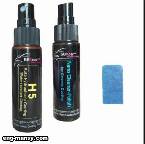Inorganic Nano Coatings 1 From 4

New, technology is constantly being used to upgrade the products we use, including the cars we own, the clothes we wear, and even the food we eat. Nano technology in particular is a growing field and is being utilized in our everyday items as material science continues its forward progress.
One area that has seen drastic upgrades with the inclusion of nano materials is the paint and coatings industry.
Paints and coatings have been used for thousands of years for a myriad of uses.
The primary reason for using paints has always been for their pleasing aesthetics.
However this has begun to change as the perception of paints as simply a way to color a surface is no longer valid.
Viewing “coatings” from a larger spectrum shows that there is much more value they can provide.
Coatings surround us in our everyday lives as they cover the interior and exterior of nearly every building we inhabit.
Their compositions have changed considerably throughout the years, primarily to make them more environmentally friendly.
Oil based paints used to be the industry standard but have now
given way to water-based latex based paints.
Volatile Organic Compounds, better known.
as “VOCs” are now known to be hazardous and are now used as little as possible.
Using water-based coatings greatly reduces the amount of VOCs that are released into the air during their application process.
Now with the advent of new coating technologies.
it is possible completely eliminate VOCs from coating systems.
Coating Technology
Coatings are broadly made up of three components: solvent, binder, and pigment.
Solvents are the part of the coating that disperses into the air and creates the all familiar ”print smell.



